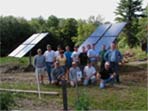
Want help in accessing the financial aspects of a renewable energy project? RET Finance (Renewable Energy Technology Financial Model) is an online calculator that simulates a 30-year nominal dollar cash flow for a variety of renewable energy projects. You can calculate project earnings, detailed cash flows and debt payments, based on your assumptions. It also computes the cost of electricity for a project, after-tax rate of return, and debt service coverage ratio. You an create several scenarios and save or send them. http://nrel.communityzero.com/retfinance
The new version of RETScreen International – used to evaluate energy production, lifecycle costs and greenhouse gas emissions – is online. It can be used for off-grid, grid-connected and water pumping projects. [sorry this link is no longer available]Whether you’re a solar do-it-yourselfer or want to get into the profession, S??nergy provides an on-line course for you. Online offerings include PV, Passive Solar Design, Environmental Building Design, Wind & Water Power, Solar Hot Water, Solar Cooking and Drying & Water Purification.
[sorry this link is no longer available]A new report, Solar Generation, concludes that solar power could provide energy for more than 1 billion people, creating over 2 million jobs by 2020, and 26% of global energy needs by 2040. The report is authored by the European Photovoltaic Industry Association (EPIA) and Greenpeace.
“It’s a realistic, achievable goal, based on the current state of the industry and opportunities in the market, but it requires clear political support from governments around the world,” says Sven Teske, Greenpeace energy expert.
The report highlights the efforts of Germany and Japan in particular, in their efforts to take a leading role in the emerging market. It calls on governments to support “innovative national incentive schemes” similar to Germany’s price support for PV, which is considered to have greatly improved the country’s solar energy sector. It outlines steps that will encourage a photovoltaic market across the globe. www.greenpeace.org/~climate/climatecountdown/solargeneration
Another recently released report, Clean Energy Blueprint shows that renewable energy – wind, biomass, geothermal and solar – can supply 20 percent of U.S. electricity by 2020. If the energy-efficiency and renewable energy policies the report recommends become law, citizens would save
over $440 billion between 2002 to 2020.
The authors suggest new minimum efficiency standards on appliances and other equipment, tax incentives for advanced energy-saving products and matching funds for state-based energy-efficiency programs. They suggest the U.S. adopt a federal renewable energy standard requiring utilities to use 20% renewable energy by 2020.
In addition to stabilizing energy prices and supply, the policies of Clean Energy Blueprint would:
* reduce U.S. use of natural gas by 31% and coal by 60%. By 2020, we would save more than could be recovered from the Arctic National Wildlife Refuge in 60 years.
* avoid the need for 975 new power plants, retire 180 old coal plants, retire 14 existing nuclear plants and reduce the need for hundreds of thousands of miles of new gas pipelines and electricity transmission lines.
* Reduce CO2 power plant emissions by two-thirds; sulfur dioxide and nitrogen oxide emissions by 55 percent… affordably.
“This report shows that there are alternative solutions to the erratic prices and supply of commodities like natural gas,” says author Alan Nogee, Director of Clean Energy Program, Union of Concerned Scientists. “Adopting a renewable energy standard would diversify electricity generation, as well as reduce air pollution and greenhouse gas emissions. It’s time for Congress to follow twelve states and adopt this standard.”
The 12 states that have adopted renewable energy standards are: Arizona, Connecticut, Iowa, Maine, Massachusetts, Minnesota, Nevada, New Jersey, New Mexico, Pennsylvania, Texas and Wisconsin.
Clean Energy Blueprint was created with assistance from the American Council for an Energy-Efficient Economy and Tellus Institute. [sorry this link is no longer available]
What are the issues confronting the development and deployment of fuel cell-powered vehicles? You can listen to the California Fuel Cell Partnership discussion on the findings of a new report, Bringing Fuel Cell Vehicles to Market: Scenarios and Challenges with Fuel Alternatives.
[sorry this link is no longer available]
